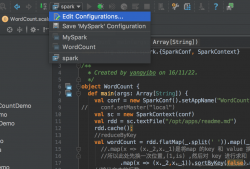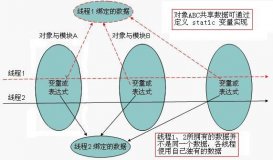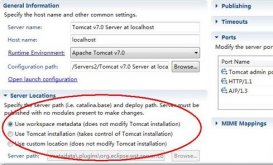前言
对于广大java开发者而已,对于J2EE规范中的Session应该并不陌生,我们可以使用Session管理用户的会话信息,最常见的就是拿Session用来存放用户登录、身份、权限及状态等信息。对于使用Tomcat作为Web容器的大部分开发人员而言,Tomcat是如何实现Session标记用户和管理Session信息的呢?
概要
SESSION
Tomcat内部定义了Session和HttpSession这两个会话相关的接口,其类继承体系如图1所示。
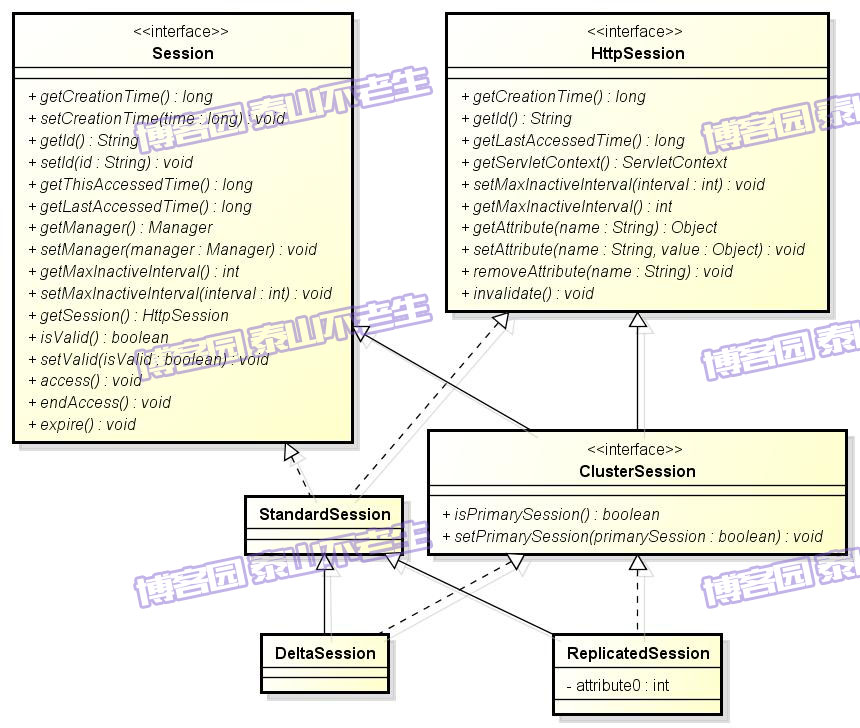
图1 Session类继承体系
图1中额外列出了Session的类继承体系,这里对他们逐个进行介绍。
Session:Tomcat中有关会话的基本接口规范,图1列出了它定义的主要方法,表1对这些方法进行介绍。
表1 Session接口说明
| 方法 | 描述 |
| getCreationTime()/setCreationTime(time : long) | 获取与设置Session的创建时间 |
| getId()/setId(id : String) | 获取与设置Session的ID |
| getThisAccessedTime() | 获取最近一次请求的开始时间 |
| getLastAccessedTime() | 获取最近一次请求的完成时间 |
| getManager()/setManager(manager : Manager) | 获取与设置Session管理器 |
| getMaxInactiveInterval()/setMaxInactiveInterval(interval : int) | 获取与设置Session的最大访问间隔 |
| getSession() | 获取HttpSession |
| isValid()/setValid(isValid : boolean) | 获取与设置Session的有效状态 |
| access()/endAccess() | 开始与结束Session的访问 |
| expire() | 设置Session过期 |
HttpSession:在HTTP客户端与HTTP服务端提供的一种会话的接口规范,图1列出了它定义的主要方法,表2对这些方法进行介绍。
表2 HttpSession接口说明
| 方法 | 描述 |
| getCreationTime() | 获取Session的创建时间 |
| getId() | 获取Session的ID |
| getLastAccessedTime() | 获取最近一次请求的完成时间 |
| getServletContext() | 获取当前Session所属的ServletContext |
| getMaxInactiveInterval()/setMaxInactiveInterval(interval : int) | 获取与设置Session的最大访问间隔 |
| getAttribute(name : String) /setAttribute(name : String, value : Object) | 获取与设置Session作用域的属性 |
| removeAttribute(name : String) | 清除Session作用域的属性 |
| invalidate() | 使Session失效并解除任何与此Session绑定的对象 |
ClusterSession:集群部署下的会话接口规范,图1列出了它的主要方法,表3对这些方法进行介绍。
表3 ClusterSession接口说明
| 方法 | 描述 |
| isPrimarySession() | 是否是集群的主Session |
| setPrimarySession(boolean primarySession) | 设置集群主Session |
StandardSession:标准的HTTP Session实现,本文将以此实现为例展开。
在部署Tomcat集群时,需要使集群中各个节点的会话状态保持同步,目前Tomcat提供了两种同步策略:
ReplicatedSession:每次都把整个会话对象同步给集群中的其他节点,其他节点然后更新整个会话对象。这种实现比较简单方便,但会造成大量无效信息的传输。
DeltaSession:对会话中增量修改的属性进行同步。这种方式由于是增量的,所以会大大降低网络I/O的开销,但是实现上会比较复杂因为涉及到对会话属性操作过程的管理。
SESSION管理器
Tomcat内部定义了Manager接口用于制定Session管理器的接口规范,目前已经有很多Session管理器的实现,如图2所示。
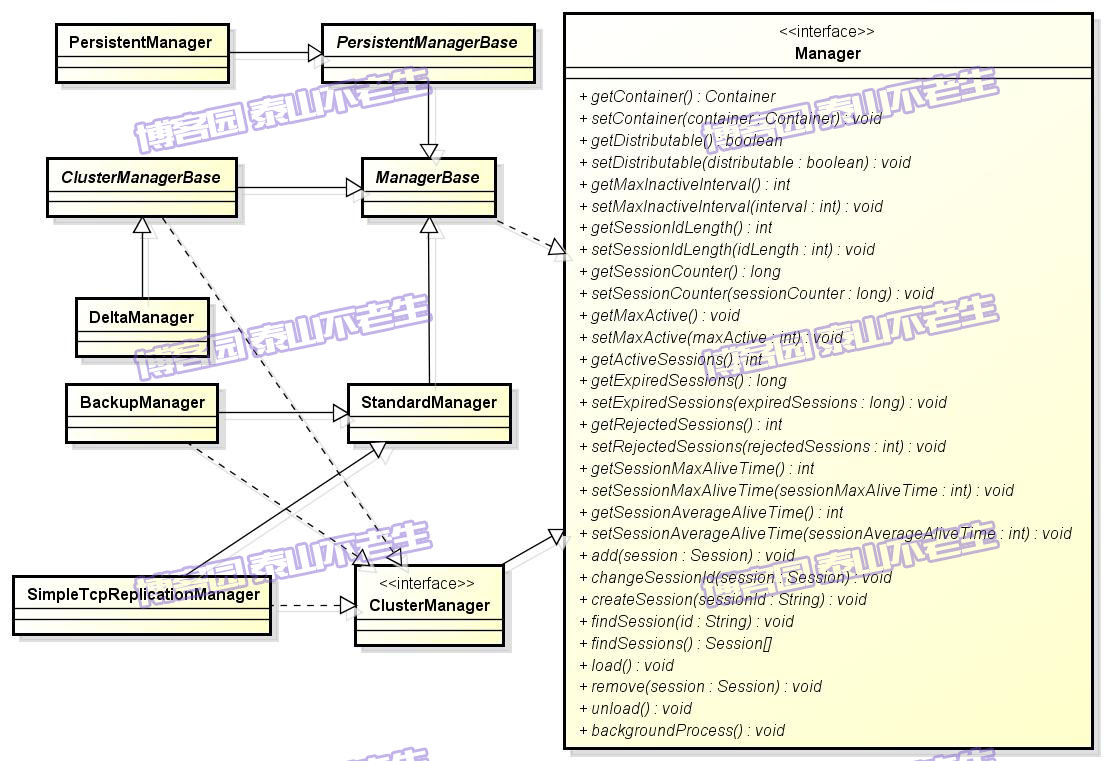
图2 Session管理器的类继承体系
对应图2中的内容我们下面逐个描述:
Manager:Tomcat对于Session管理器定义的接口规范,图2已经列出了Manager接口中定义的主要方法,表4详细描述了这些方法的作用。
表4 Manager接口说明
| 方法 | 描述 |
| getContainer()/setContainer(container : Container) | 获取或设置Session管理器关联的容器,一般为Context容器 |
| getDistributable()/setDistributable(distributable : boolean) | 获取或设置Session管理器是否支持分布式 |
| getMaxInactiveInterval()/setMaxInactiveInterval(interval : int) | 获取或设置Session管理器创建的Session的最大非活动时间间隔 |
| getSessionIdLength()/setSessionIdLength(idLength : int) | 获取或设置Session管理器创建的Session ID的长度 |
| getSessionCounter()/setSessionCounter(sessionCounter : long) | 获取或设置Session管理器创建的Session总数 |
| getMaxActive()/setMaxActive(maxActive : int) | 获取或设置当前已激活Session的最大数量 |
| getActiveSessions() | 获取当前激活的所有Session |
| getExpiredSessions()/setExpiredSessions(expiredSessions : long) | 获取或设置当前已过期Session的数量 |
| getRejectedSessions()/setRejectedSessions(rejectedSessions : int) | 获取或设置已拒绝创建Session的数量 |
| getSessionMaxAliveTime()/setSessionMaxAliveTime(sessionMaxAliveTime : int) | 获取或设置已过期Session中的最大活动时长 |
| getSessionAverageAliveTime()/setSessionAverageAliveTime(sessionAverageAliveTime : int) | 获取或设置已过期Session的平均活动时长 |
| add(session : Session)/remove(session : Session) | 给Session管理器增加或删除活动Session |
| changeSessionId(session : Session) | 给Session设置新生成的随机Session ID |
| createSession(sessionId : String) | 基于Session管理器的默认属性配置创建新的Session |
| findSession(id : String) | 返回sessionId参数唯一标记的Session |
| findSessions() | 返回Session管理器管理的所有活动Session |
| load()/unload() | 从持久化机制中加载Session或向持久化机制写入Session |
| backgroundProcess() | 容器接口中定义的为具体容器在后台处理相关工作的实现,Session管理器基于此机制实现了过期Session的销毁 |
ManagerBase:封装了Manager接口通用实现的抽象类,未提供对load()/unload()等方法的实现,需要具体子类去实现。所有的Session管理器都继承自ManagerBase。
ClusterManager:在Manager接口的基础上增加了集群部署下的一些接口,所有实现集群下Session管理的管理器都需要实现此接口。
PersistentManagerBase:提供了对于Session持久化的基本实现。
PersistentManager:继承自PersistentManagerBase,可以在Server.xml的<Context>元素下通过配置<Store>元素来使用。PersistentManager可以将内存中的Session信息备份到文件或数据库中。当备份一个Session对象时,该Session对象会被复制到存储器(文件或者数据库)中,而原对象仍然留在内存中。因此即便服务器宕机,仍然可以从存储器中获取活动的Session对象。如果活动的Session对象超过了上限值或者Session对象闲置了的时间过长,那么Session会被换出到存储器中以节省内存空间。
StandardManager:不用配置<Store>元素,当Tomcat正常关闭,重启或Web应用重新加载时,它会将内存中的Session序列化到Tomcat目录下的/work/Catalina/host_name/webapp_name/SESSIONS.ser文件中。当Tomcat重启或应用加载完成后,Tomcat会将文件中的Session重新还原到内存中。如果突然终止该服务器,则所有Session都将丢失,因为StandardManager没有机会实现存盘处理。
ClusterManagerBase:提供了对于Session的集群管理实现。
DeltaManager:继承自ClusterManagerBase。此Session管理器是Tomcat在集群部署下的默认管理器,当集群中的某一节点生成或修改Session后,DeltaManager将会把这些修改增量复制到其他节点。
BackupManager:没有继承ClusterManagerBase,而是直接实现了ClusterManager接口。是Tomcat在集群部署下的可选的Session管理器,集群中的所有Session都被全量复制到一个备份节点。集群中的所有节点都可以访问此备份节点,达到Session在集群下的备份效果。
为简单起见,本文以StandardManager为例讲解Session的管理。StandardManager是StandardContext的子组件,用来管理当前Context的所有Session的创建和维护。如果你应经阅读或者熟悉了《Tomcat源码分析——生命周期管理》一文的内容,那么你就知道当StandardContext正式启动,也就是StandardContext的startInternal方法(见代码清单1)被调用时,StandardContext还会启动StandardManager。
代码清单1
|
1
2
3
4
5
6
7
8
9
10
11
12
13
14
15
16
17
18
19
20
21
22
23
24
25
26
27
28
29
30
31
32
33
34
35
36
37
38
39
40
|
@Override protected synchronized void startInternal() throws LifecycleException { // 省略与Session管理无关的代码 // Acquire clustered manager Manager contextManager = null; if (manager == null) { if ( (getCluster() != null) && distributable) { try { contextManager = getCluster().createManager(getName()); } catch (Exception ex) { log.error("standardContext.clusterFail", ex); ok = false; } } else { contextManager = new StandardManager(); } } // Configure default manager if none was specified if (contextManager != null) { setManager(contextManager); } if (manager!=null && (getCluster() != null) && distributable) { //let the cluster know that there is a context that is distributable //and that it has its own manager getCluster().registerManager(manager); } // 省略与Session管理无关的代码 try { // Start manager if ((manager != null) && (manager instanceof Lifecycle)) { ((Lifecycle) getManager()).start(); } // Start ContainerBackgroundProcessor thread super.threadStart(); } catch(Exception e) { log.error("Error manager.start()", e); ok = false; } // 省略与Session管理无关的代码 } |
从代码清单1可以看到StandardContext的startInternal方法中涉及Session管理的执行步骤如下:
创建StandardManager;
如果Tomcat结合Apache做了分布式部署,会将当前StandardManager注册到集群中;
启动StandardManager;
StandardManager的start方法用于启动StandardManager,实现见代码清单2。
代码清单2
|
1
2
3
4
5
6
7
8
9
10
11
12
13
14
15
16
17
18
19
20
21
22
23
24
25
26
27
|
@Override public synchronized final void start() throws LifecycleException { //省略状态校验的代码if (state.equals(LifecycleState.NEW)) { init(); } else if (!state.equals(LifecycleState.INITIALIZED) && !state.equals(LifecycleState.STOPPED)) { invalidTransition(Lifecycle.BEFORE_START_EVENT); } setState(LifecycleState.STARTING_PREP); try { startInternal(); } catch (LifecycleException e) { setState(LifecycleState.FAILED); throw e; } if (state.equals(LifecycleState.FAILED) || state.equals(LifecycleState.MUST_STOP)) { stop(); } else { // Shouldn't be necessary but acts as a check that sub-classes are // doing what they are supposed to. if (!state.equals(LifecycleState.STARTING)) { invalidTransition(Lifecycle.AFTER_START_EVENT); } setState(LifecycleState.STARTED); } } |
从代码清单2可以看出启动StandardManager的步骤如下:
调用init方法初始化StandardManager;
调用startInternal方法启动StandardManager;
STANDARDMANAGER的初始化
经过上面的分析,我们知道启动StandardManager的第一步就是调用父类LifecycleBase的init方法,关于此方法已在《Tomcat源码分析——生命周期管理》一文详细介绍,所以我们只需要关心StandardManager的initInternal。StandardManager本身并没有实现initInternal方法,但是StandardManager的父类ManagerBase实现了此方法,其实现见代码清单3。
代码清单3
|
1
2
3
4
5
6
7
|
@Override protected void initInternal() throws LifecycleException { super.initInternal(); setDistributable(((Context) getContainer()).getDistributable()); // Initialize random number generation getRandomBytes(new byte[16]); } |
阅读代码清单3,我们总结下ManagerBase的initInternal方法的执行步骤:
将容器自身即StandardManager注册到JMX(LifecycleMBeanBase的initInternal方法的实现请参考《Tomcat源码分析——生命周期管理》一文);
从父容器StandardContext中获取当前Tomcat是否是集群部署,并设置为ManagerBase的布尔属性distributable;
调用getRandomBytes方法从随机数文件/dev/urandom中获取随机数字节数组,如果不存在此文件则通过反射生成java.security.SecureRandom的实例,用它生成随机数字节数组。
注意:此处调用getRandomBytes方法生成的随机数字节数组并不会被使用,之所以在这里调用实际是为了完成对随机数生成器的初始化,以便将来分配Session ID时使用。
我们详细阅读下getRandomBytes方法的代码实现,见代码清单4。
代码清单4
|
1
2
3
4
5
6
7
8
9
10
11
12
13
14
15
16
17
18
19
20
21
22
23
24
25
26
|
protected void getRandomBytes(byte bytes[]) { // Generate a byte array containing a session identifier if (devRandomSource != null && randomIS == null) { setRandomFile(devRandomSource); } if (randomIS != null) { try { int len = randomIS.read(bytes); if (len == bytes.length) { return; } if(log.isDebugEnabled()) log.debug("Got " + len + " " + bytes.length ); } catch (Exception ex) { // Ignore } devRandomSource = null; try { randomIS.close(); } catch (Exception e) { log.warn("Failed to close randomIS."); } randomIS = null; } getRandom().nextBytes(bytes); } |
代码清单4中的setRandomFile
方法(见代码清单5)用于从随机数文件/dev/urandom中获取随机数字节数组。
代码清单5
|
1
2
3
4
5
6
7
8
9
10
11
12
13
14
15
16
17
18
19
20
21
22
23
24
25
26
27
28
|
public void setRandomFile( String s ) { // as a hack, you can use a static file - and generate the same // session ids ( good for strange debugging ) if (Globals.IS_SECURITY_ENABLED){ randomIS = AccessController.doPrivileged(new PrivilegedSetRandomFile(s)); } else { try{ devRandomSource=s; File f=new File( devRandomSource ); if( ! f.exists() ) return; randomIS= new DataInputStream( new FileInputStream(f)); randomIS.readLong(); if( log.isDebugEnabled() ) log.debug( "Opening " + devRandomSource ); } catch( IOException ex ) { log.warn("Error reading " + devRandomSource, ex); if (randomIS != null) { try { randomIS.close(); } catch (Exception e) { log.warn("Failed to close randomIS."); } } devRandomSource = null; randomIS=null; } } } |
代码清单4中的setRandomFile方法(见代码清单6)通过反射生成java.security.SecureRandom的实例,并用此实例生成随机数字节数组。
代码清单6
|
1
2
3
4
5
6
7
8
9
10
11
12
13
14
15
16
17
18
19
20
21
22
23
24
25
26
27
28
29
30
|
public Random getRandom() { if (this.random == null) { // Calculate the new random number generator seed long seed = System.currentTimeMillis(); long t1 = seed; char entropy[] = getEntropy().toCharArray(); for (int i = 0; i < entropy.length; i++) { long update = ((byte) entropy[i]) << ((i % 8) * 8); seed ^= update; } try { // Construct and seed a new random number generator Class<?> clazz = Class.forName(randomClass); this.random = (Random) clazz.newInstance(); this.random.setSeed(seed); } catch (Exception e) { // Fall back to the simple case log.error(sm.getString("managerBase.random", randomClass), e); this.random = new java.util.Random(); this.random.setSeed(seed); } if(log.isDebugEnabled()) { long t2=System.currentTimeMillis(); if( (t2-t1) > 100 ) log.debug(sm.getString("managerBase.seeding", randomClass) + " " + (t2-t1)); } } return (this.random); } |
根据以上的分析,StandardManager的初始化主要就是执行了ManagerBase的initInternal方法。
STANDARDMANAGER的启动
调用StandardManager的startInternal方法用于启动StandardManager,见代码清单7。
代码清单7
|
1
2
3
4
5
6
7
8
9
10
11
12
13
14
15
16
|
@Override protected synchronized void startInternal() throws LifecycleException { // Force initialization of the random number generator if (log.isDebugEnabled()) log.debug("Force random number initialization starting"); generateSessionId(); if (log.isDebugEnabled()) log.debug("Force random number initialization completed"); // Load unloaded sessions, if any try { load(); } catch (Throwable t) { log.error(sm.getString("standardManager.managerLoad"), t); } setState(LifecycleState.STARTING); } |
从代码清单7可以看出启动StandardManager的步骤如下:
步骤一 调用generateSessionId方法(见代码清单8)生成新的Session ID;
代码清单8
|
1
2
3
4
5
6
7
8
9
10
11
12
13
14
15
16
17
18
19
20
21
22
23
24
25
26
27
28
29
30
31
32
33
34
35
36
37
38
|
protected synchronized String generateSessionId() { byte random[] = new byte[16]; String jvmRoute = getJvmRoute(); String result = null; // Render the result as a String of hexadecimal digits StringBuilder buffer = new StringBuilder(); do { int resultLenBytes = 0; if (result != null) { buffer = new StringBuilder(); duplicates++; } while (resultLenBytes < this.sessionIdLength) { getRandomBytes(random); random = getDigest().digest(random); for (int j = 0; j < random.length && resultLenBytes < this.sessionIdLength; j++) { byte b1 = (byte) ((random[j] & 0xf0) >> 4); byte b2 = (byte) (random[j] & 0x0f); if (b1 < 10) buffer.append((char) ('0' + b1)); else buffer.append((char) ('A' + (b1 - 10))); if (b2 < 10) buffer.append((char) ('0' + b2)); else buffer.append((char) ('A' + (b2 - 10))); resultLenBytes++; } } if (jvmRoute != null) { buffer.append('.').append(jvmRoute); } result = buffer.toString(); } while (sessions.containsKey(result)); return (result); } |
步骤二 加载持久化的Session信息。为什么Session需要持久化?由于在StandardManager中,所有的Session都维护在一个ConcurrentHashMap中,因此服务器重启或者宕机会造成这些Session信息丢失或失效,为了解决这个问题,Tomcat将这些Session通过持久化的方式来保证不会丢失。下面我们来看看StandardManager的load方法的实现,见代码清单9所示。
代码清单9
|
1
2
3
4
5
6
7
8
9
10
11
12
13
14
15
16
17
18
19
|
public void load() throws ClassNotFoundException, IOException { if (SecurityUtil.isPackageProtectionEnabled()){ try{ AccessController.doPrivileged( new PrivilegedDoLoad() ); } catch (PrivilegedActionException ex){ Exception exception = ex.getException(); if (exception instanceof ClassNotFoundException){ throw (ClassNotFoundException)exception; } else if (exception instanceof IOException){ throw (IOException)exception; } if (log.isDebugEnabled()) log.debug("Unreported exception in load() " + exception); } } else { doLoad(); } } |
如果需要安全机制是打开的并且包保护模式打开,会通过创建PrivilegedDoLoad来加载持久化的Session,其实现如代码清单10所示。
代码清单10
|
1
2
3
4
5
6
7
8
9
10
|
private class PrivilegedDoLoad implements PrivilegedExceptionAction<Void> { PrivilegedDoLoad() { // NOOP } public Void run() throws Exception{ doLoad(); return null; } } |
从代码清单10看到实际负责加载的方法是doLoad,根据代码清单9知道默认情况下,加载Session信息的方法也是doLoad。所以我们只需要看看doLoad的实现了,见代码清单11。
代码清单11
|
1
2
3
4
5
6
7
8
9
10
11
12
13
14
15
16
17
18
19
20
21
22
23
24
25
26
27
28
29
30
31
32
33
34
35
36
37
38
39
40
41
42
43
44
45
46
47
48
49
50
51
52
53
54
55
56
57
58
59
60
61
62
63
64
65
66
67
68
69
70
71
72
73
74
75
76
77
78
79
80
81
82
83
84
85
86
87
88
89
90
91
92
93
94
95
96
97
98
99
100
101
102
103
104
105
106
|
protected void doLoad() throws ClassNotFoundException, IOException { if (log.isDebugEnabled()) log.debug("Start: Loading persisted sessions"); // Initialize our internal data structures sessions.clear(); // Open an input stream to the specified pathname, if any File file = file(); if (file == null) return; if (log.isDebugEnabled()) log.debug(sm.getString("standardManager.loading", pathname)); FileInputStream fis = null; BufferedInputStream bis = null; ObjectInputStream ois = null; Loader loader = null; ClassLoader classLoader = null; try { fis = new FileInputStream(file.getAbsolutePath()); bis = new BufferedInputStream(fis); if (container != null) loader = container.getLoader(); if (loader != null) classLoader = loader.getClassLoader(); if (classLoader != null) { if (log.isDebugEnabled()) log.debug("Creating custom object input stream for class loader "); ois = new CustomObjectInputStream(bis, classLoader); } else { if (log.isDebugEnabled()) log.debug("Creating standard object input stream"); ois = new ObjectInputStream(bis); } } catch (FileNotFoundException e) { if (log.isDebugEnabled()) log.debug("No persisted data file found"); return; } catch (IOException e) { log.error(sm.getString("standardManager.loading.ioe", e), e); if (fis != null) { try { fis.close(); } catch (IOException f) { // Ignore } } if (bis != null) { try { bis.close(); } catch (IOException f) { // Ignore } } throw e; } // Load the previously unloaded active sessions synchronized (sessions) { try { Integer count = (Integer) ois.readObject(); int n = count.intValue(); if (log.isDebugEnabled()) log.debug("Loading " + n + " persisted sessions"); for (int i = 0; i < n; i++) { StandardSession session = getNewSession(); session.readObjectData(ois); session.setManager(this); sessions.put(session.getIdInternal(), session); session.activate(); if (!session.isValidInternal()) { // If session is already invalid, // expire session to prevent memory leak. session.setValid(true); session.expire(); } sessionCounter++; } } catch (ClassNotFoundException e) { log.error(sm.getString("standardManager.loading.cnfe", e), e); try { ois.close(); } catch (IOException f) { // Ignore } throw e; } catch (IOException e) { log.error(sm.getString("standardManager.loading.ioe", e), e); try { ois.close(); } catch (IOException f) { // Ignore } throw e; } finally { // Close the input stream try { ois.close(); } catch (IOException f) { // ignored } // Delete the persistent storage file if (file.exists() ) file.delete(); } } if (log.isDebugEnabled()) log.debug("Finish: Loading persisted sessions"); } |
从代码清单11看到StandardManager的doLoad方法的执行步骤如下:
清空sessions缓存维护的Session信息;
调用file方法返回当前Context下的Session持久化文件,比如:D:workspaceTomcat7.0workCatalinalocalhosthost-managerSESSIONS.ser;
打开Session持久化文件的输入流,并封装为CustomObjectInputStream;
从Session持久化文件读入持久化的Session的数量,然后逐个读取Session信息并放入sessions缓存中。
至此,有关StandardManager的启动就介绍到这里,我将会在下篇内容讲解Session的分配、追踪、销毁等内容。

